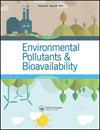Fractionation of heavy metals in contaminated soils surrounding non-ferrous metals smelting area in the North China Plain
Q3 Chemical Engineering
引用次数: 19
Abstract
Abstract The accumulation of heavy metals in soil is a serious environmental problem. The risk of metals in soil is associated critically with their species. Operationally determined speciation analysis of Cr, Mn, Ni, Cu, Zn, Sb, Cd and Pb was carried out in the area of non-ferrous metals-smelting in the North China Plain, using inductively coupled plasma-mass spectroscopy after sequential chemical extraction. The average potential mobility fraction was calculated. The average potential mobility of the metals had the following order: Cd(44.7%) > Pb(29.6%) > Mn(14.8%) > Zn(12.5%) > Cu(5.9%) > Sb(5.0%) > Ni(2.1%) > Cr(0.8%). It is concluded that there is a distinct spatial heterogeneity in the concentration of heavy metals in the studied area. The results indicate that the polluting heavy metals, in particular Cd and Pb, have high potential mobility.华北平原有色金属冶炼区周边污染土壤重金属分馏特征
重金属在土壤中的积累是一个严重的环境问题。土壤中金属的风险与其种类密切相关。采用顺序化学萃取后的电感耦合等离子体质谱技术,对华北平原有色金属冶炼地区的Cr、Mn、Ni、Cu、Zn、Sb、Cd和Pb进行了可操作的形态分析。计算平均潜在迁移率。金属的平均电位迁移率依次为:Cd(44.7%) > Pb(29.6%) > Mn(14.8%) > Zn(12.5%) > Cu(5.9%) > Sb(5.0%) > Ni(2.1%) > Cr(0.8%)。结果表明,研究区重金属浓度存在明显的空间异质性。结果表明,污染重金属,特别是Cd和Pb具有较高的电位迁移率。
本文章由计算机程序翻译,如有差异,请以英文原文为准。
求助全文
约1分钟内获得全文
求助全文
来源期刊
CiteScore
1.62
自引率
0.00%
发文量
0
审稿时长
1 months
期刊介绍:
Chemical Speciation & Bioavailability ( CS&B) is a scholarly, peer-reviewed forum for insights on the chemical aspects of occurrence, distribution, transport, transformation, transfer, fate, and effects of substances in the environment and biota, and their impacts on the uptake of the substances by living organisms. Substances of interests include both beneficial and toxic ones, especially nutrients, heavy metals, persistent organic pollutants, and emerging contaminants, such as engineered nanomaterials, as well as pharmaceuticals and personal-care products as pollutants. It is the aim of this Journal to develop an international community of experienced colleagues to promote the research, discussion, review, and spread of information on chemical speciation and bioavailability, which is a topic of interest to researchers in many disciplines, including environmental, chemical, biological, food, medical, toxicology, and health sciences.
Key themes in the scope of the Journal include, but are not limited to, the following “6Ms”:
Methods for speciation analysis and the evaluation of bioavailability, especially the development, validation, and application of novel methods and techniques.
Media that sustain the processes of release, distribution, transformation, and transfer of chemical speciation; of particular interest are emerging contaminants, such as engineered nanomaterials, pharmaceuticals, and personal-care products.
Mobility of substance species in environment and biota, either spatially or temporally.
Matters that influence the chemical speciation and bioavailability, mainly environmentally relevant conditions.
Mechanisms that govern the transport, transformation, transfer, and fate of chemical speciation in the environment, and the biouptake of substances.
Models for the simulation of chemical speciation and bioavailability, and for the prediction of toxicity.
Chemical Speciation & Bioavailability is a fully open access journal. This means all submitted articles will, if accepted, be available for anyone to read, anywhere, at any time. immediately on publication. There are no charges for submission to this journal.

 求助内容:
求助内容: 应助结果提醒方式:
应助结果提醒方式:


